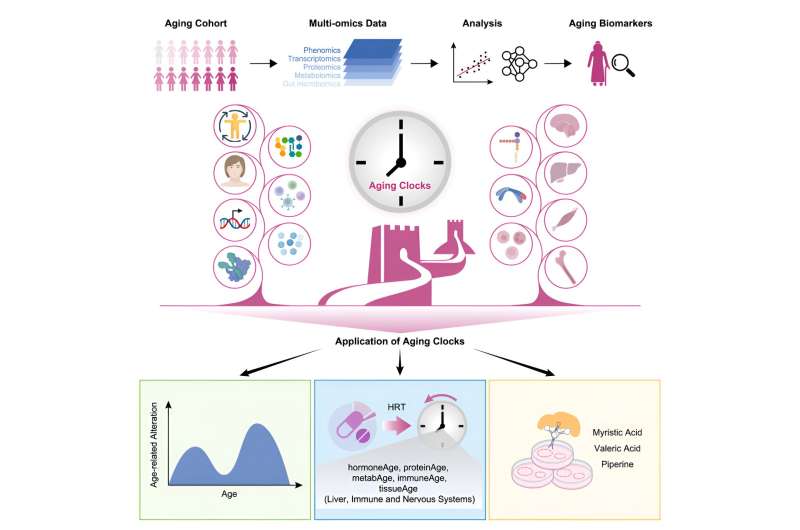August 1, 2023 report
This article has been reviewed according to Science X's editorial process and policies. Editors have highlighted the following attributes while ensuring the content's credibility:
fact-checked
peer-reviewed publication
trusted source
proofread
Molecular indicators found to predict the pace of aging in women

Research led by the Chinese Academy of Sciences and Quzhou People's Hospital, China, has used multi-omics profiling to track the markers of aging in women. In a paper titled, "Determining a multimodal aging clock in a cohort of Chinese women," published in the journal Med, the researchers use multiple snapshots of omics at single timepoints from women of different ages to get a picture of how aging markers might change over a lifetime.
A cohort of 113 healthy female volunteers of 20–66 years old, all residing in a city in southern China, took part in a comprehensive physical evaluation, answered survey questions, and underwent collection of blood and fecal specimens for multi-omics data profiling. The resulting analyses included transcripts, proteins, metabolites, microbes, and clinical laboratory values of the samples and were correlated to evaluations and chronological age.
From the analysis, four aging modalities were defined, each linked to distinct biological functions, namely chronic inflammation, lipid metabolism, hormone regulation, and tissue fitness. Interestingly, waves of changes in these pathways were observed, peaking around the third and fifth decades of life.
To identify genetic, environmental, and lifestyle factors that might influence the aging pace, the team analyzed the aging metrics with traits obtained from the questionnaire, such as eating habits, lifestyle, reproductive aging symptoms, and self-reported health status.
The results show that the pace of different age estimators is positively associated with the degrees of hot flushing and reproductive aging symptoms, and negatively associated with healthy eating habits that include fruits and grains. The immune-age pace was negatively correlated with frequency of drinking tea per week. The aging rate of nervous and muscle protein-age was positively associated with body pain.
Multilayered features display different waves of alterations with aging. This approach pinpointed peaks of differentially presented features along the aging trajectory. While the wave patterns varied across distinct data modalities, two crests formed at around the ages 30 and 50. Two peaks only share a small proportion of changes, indicating that women age differently at distinct ages.
These two peaks are also the time points that generally split the volunteers into two groups according to their history of giving birth and menopause status. The 30-year-old stage was characterized by lipid and hormone metabolism changes, while the 50-year-old stage coincided with menopausal changes.
Since circulatory hormone levels are highly correlated with female aging, the team looked into whether hormone replacement therapy (HRT) could mitigate aging-related changes. A subgroup of 24 individuals within the study undergoing HRT was associated with more robust maintenance of the T cell pool and alleviation of aging-associated immunosenescence, suggesting that HRT, to some extent, decelerates aging in women.
Gut microbiota composition did not seem to be as correlated with age. Only Paraburkholderia fungorum was positively correlated with age, while Ruminococcus bicirculans, which plays a role in degradation of cellulose and xylan, was inversely correlated.
The findings are consistent with existing knowledge of age-related markers, and while the authors suggest that the modeling of several omics can predict age, the opposite is also true: A person's age would be a good predictor of several omics. The intersection of interest is what can be learned when the two do not match, and future research could use this study's findings to explore the mechanisms of accelerated or delayed aging.
More information: Jiaming Li et al, Determining a multimodal aging clock in a cohort of Chinese women, Med (2023). DOI: 10.1016/j.medj.2023.06.010
© 2023 Science X Network



















